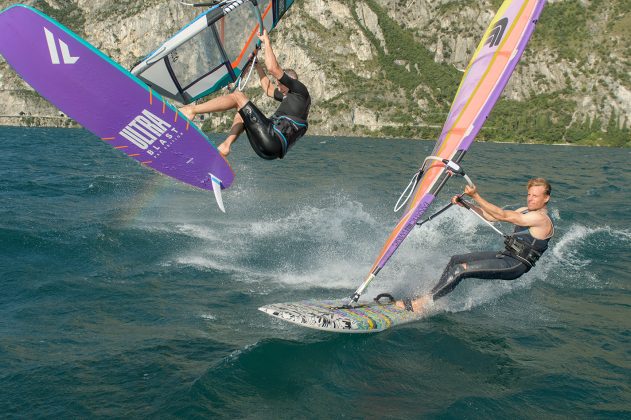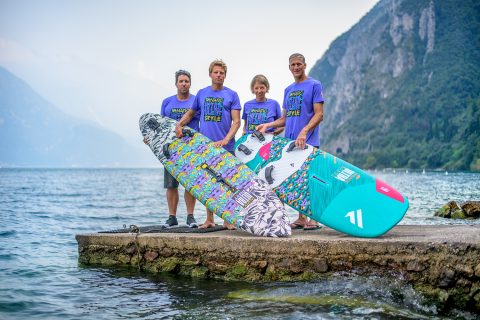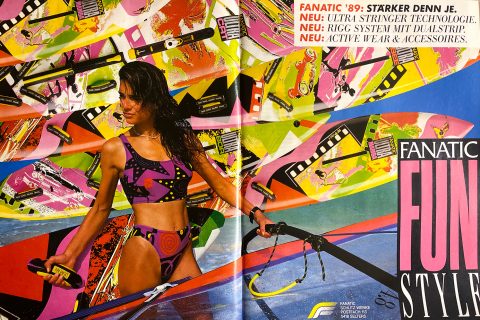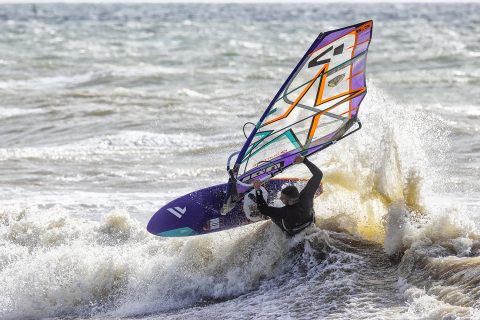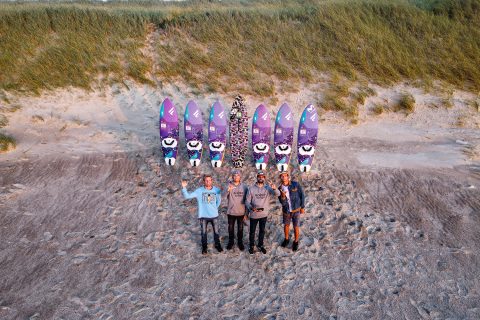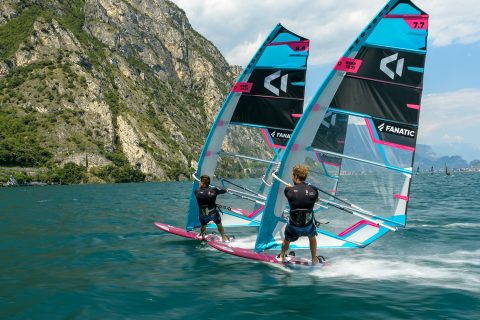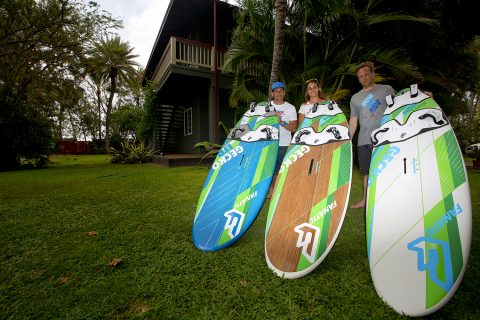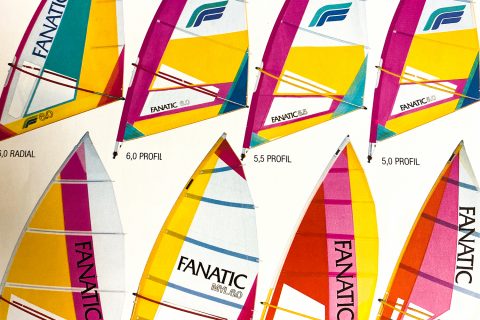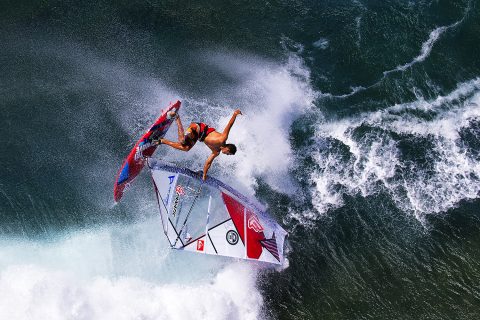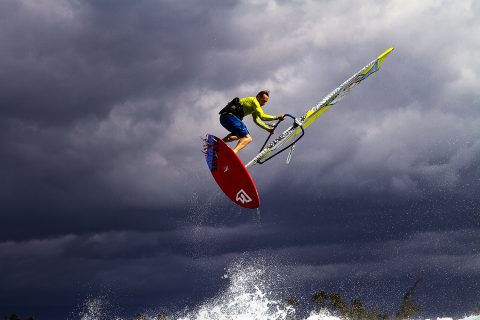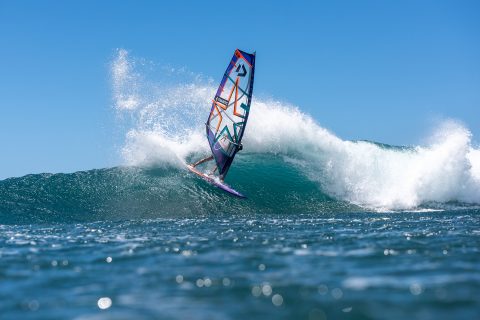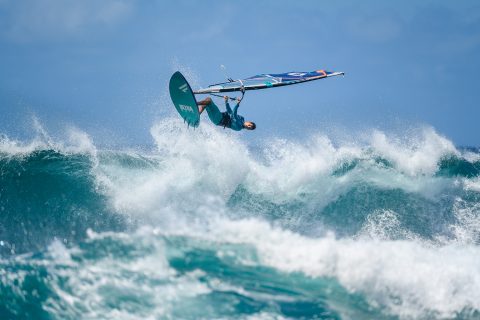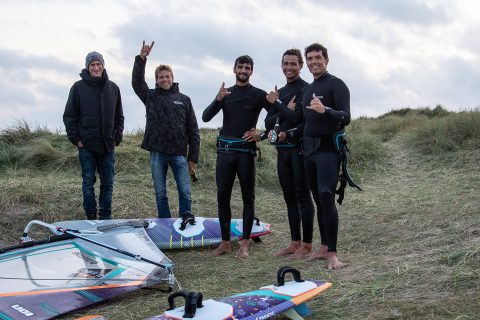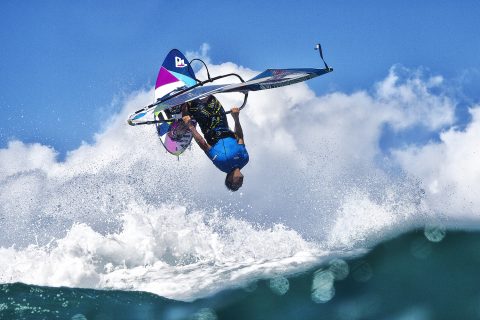From our October issue we look back at Fanatic who celebrate 40 years in business in 2021 with a history of producing iconic boards and a team that has delivered multiple PWA world titles. Their brand manager, Craig Gertenbach, gives us an insight into the roots and workings of the company and the riders and moments that helped shape the brand and make it the success it is today.
Words Craig Gertenbach // Photos Ronny Kiaulehn, Fish Bowl Diaries and John Carter
To read more features like this first, Print and Digital subscriptions are available. Prices include delivery globally for 10 x issues a year!
ROOTS
The brand was started by Udo Schütz, who was an industrialist based in central Germany close to Frankfurt. He was a successful motor racing driver, actually a test driver for Porsche at the time. In the beginning Fanatic was very much a German company, very focussed on technology. They had their own moulds and produced all their own boards using materials right from the start that were pretty high-tech, like a lot of honeycomb materials that Udo sourced with his industry connections, and they were able to put a lot of value into the boards. They were building production boards by literally putting in raw material at one end and it would go over a fully automated production line. The last couple of steps to sorting out the rails or doing a few things were done by hand, but otherwise it was really automated to produce huge volumes of high quality boards. Obviously back then moulds were really expensive, but the philosophy of the brand was to really spend a lot of money on technology to give the product a very unique selling point. It was really high-end technology, and from my point of view, the first time I ever saw any Fanatic boards or owned any Fanatic boards, the graphics were always a little different to what everybody else had, a lot more colourful and risky, edgy colours instead of the classic corporate design, so I think that is something through the 40 years to even today we have managed to adhere to.
- Fanatic crew in Lake Garda
TECHNICAL
Technically too we have always been at the fore; Fanatic was the first major brand to produce at the Cobra factory in Thailand, so we’ve been there the longest. And we were one of the first brands to have full time technical engineers and use CAD design. We also co-operate with a lot of companies, like with our use of the TeXtreme® material in our boards. So it’s quite a technical and precise approach, but in terms of optics also quite emotional, and a bit more provocative. People might remember the first mosquito graphics we did on boards, I have one in my office actually and it still looks amazing after 30 years. That’s where we’re coming from in our 40th year collection, bringing back those really emotional designs and names, reminding people of boards they had as a teenager or their father or grandfather had.
- The good old days!
FIRST IMPRESSIONS
My very first Fanatic board was a ‘Racy Cat’ that I bought. It was actually my first racing kit, and quite a legendary board, everyone had one. And I was amazed back then by its light weight, technically it was unbelievable. And of course, just as impressive was the name and optics. And then I remember later, when I was working for F2 from about 1986 onwards, we were testing with Werner Gigler, who taught me most of the stuff I know about testing back in the day. He would get a bunch of boards for cross testing against his own products and the Fanatic was just like, optically in terms of the graphics and the weights and technology, was just ridiculous compared to the rest, it was a real mind blower and that kind of stayed with me. The next big impression for me, and I can remember the moment really clearly, was watching the World Cup event in South Africa. Cesare Cantagalli did the first cheese roll in competition at it; that was quite a moment for everyone. It was just after the Aloha Classic where there had been a few killer loops and stuff. But Cesare came over to South Africa with a few other World Cup’ers like Robert Teriitehau, and he was doing these amazing, beautifully landed cheese rolls and that was his big moment, that’s when he shot to fame basically at the end of the 80s and early 90s introducing that move. He was riding for Fanatic and he had that ‘Mosquito’ board with its incredible design.
- Nik Baker shredding in 2020
That was a big defining moment for me, and I remember my friends and I watched it live on TV, and we went out in Langebaan afterwards. We were flat water sailors aged 16, and immediately tried to do a cheese roll on not really the right equipment for trying that stuff. So Cesare’s performances were a defining moment for the brand and there were generations of riders who sort of drove Fanatic’s image through the years. In the early 80s it would have been Philip Pudenz and shaper Marco Copello initially, and then came the generation which started with Cesare Cantagalli, Fabien Pendle, Torkil Kristensen and Nik Baker, and that carried on through to the 90s. But Cesare was one of the guys who really drove Fanatic in terms of wave image back then. He flew around the world to all these amazing locations with his ‘Globotour’, bringing back incredible images, at a time when there was no GoPro’s, so it involved lots of mountings. Cesare helped move Fanatic away from the image of a German technically oriented brand into a more wave image. He was a very stylish character on the water and still is, and his time at Fanatic was a pivotal moment for the brand.
- Fanatic team in Denmark
CHARACTERS
There were some massive characters on tour back then, guys like Robert Teriitehau and so many others. Maui Meyer was one of them, and he was using ART sails and Fanatic boards and his whole setup just looked amazing. The next guy who would have made a huge impression was Nik Baker, also riding for Fanatic and ART. Nik was one of the first professionals who really took it seriously with training and his equipment. And he had great backing, huge outside sponsors, like Sega, Red Bull and Oxbow as well as Fanatic and ART right behind him. He was one of the first guys to put up a serious challenge to Bjorn in the 90s, even though he was quite a bit smaller than him, and winning all those indoor events. So he was a great brand shaper for Fanatic and, in fact, in the mid 90s Fanatic went a little bit in the direction of calling themselves the ‘Boarders company’, making wakeboards, surfboards, kite boards and all kinds of stuff. They cut their massive world cup team at that time, but kept Nik as a sort of ‘waterman’ to promote all that gear. He was one of the key players for the brand from 1994 to the end of the 90s.
- Blasting in Garda
R&D
Around that same time, shaper Sebastian Wenzel started working with Fanatic. He began with the company in 1994 and became the exclusive shaper in 1997, and that’s when things started changing also a little bit, especially in our company. Klaas Voget just did an interview with Ralf Bachschuster, who was also one of the leading guys for Fanatic in the 90s, and he was mentioning how much money pros spent on custom boards back then and how they could just order a board from anybody and get the stickers put on it and not be involved in the R&D. Fanatic did involve the riders a bit more, but basically when we started with Sebastian when I joined the company in 1995, they had an idea of having 3 shapers and letting myself and the rest of the testing team review the boards and then decide which shape would be the best, so it would be like an internal competition. And that lasted for about a year and a half and then we decided after splitting the range between three shapers to work with Sebastian exclusively. Then in 1997, we decided as a company that it would be important, instead of sending people money and stickers, to involve everybody a hundred percent in the development process and we made it mandatory for all riders to use Sebastian’s boards and they weren’t allowed to use anything else. And that’s been our business model for the last 23 years, except for a short period when Francisco Goya was in the team and was allowed to get extra boards from Keith Teboul. He won his first title riding a Wenzel shape and kicked off an amazing series of Goya Pro Models by Fanatic, a real brand shaper for us for many years.
- Sebastian Wenzel and the Gecko team 2013
Making sure riders work with the shaper is a key element to success. If you’re going to pay somebody to promote your product, they’ve also got to believe in the product and use something that’s been made by your shaper, so that you can actually improve your shaper and make your marketing more authentic. That was something I pushed even stronger for when I became a brand manager in 2004. So we continued with that policy until today. It’s cost us a few potential team riders a couple of times, who wanted to have boards from other shapers and we just didn’t allow it. But that’s been quite a good thing for us because we’ve seen Sebastian obviously growing as a shaper and getting better. Letting riders go off and do their own thing, that’s just a waste of resources because they can give really good feedback if they are channelled properly.
- Fanatic sails advert
CHANGES
Fanatic was sold at the end of 1999 to the Mistral group where you had Mistral, F2, Fanatic, and the sail brands, ART, North Sails and Arrow sails, as well as the snowboard and accessory brands. In 2000 Boards & More was founded through a merger of F2, Fanatic and Mistral, and they decided to restart the marketing away from one rider doing all the sports, which was Nik Baker, and then later Rush Randle, who was sort of seen as the ‘waterman’ for the whole company. So there was a push again to get new riders. They kept Rush Randle and gave him a pro model, which had a skull graphic on the nose! That same year Francisco Goya came into the team and got his own pro model with the sun graphic on it that he did with our graphics agency and helped us a lot to gain back some image in terms of the wave market. And we launched the very first freewave board, which was absolutely groundbreaking at the time, because that was the first time someone had made a wave board that was really good in onshore conditions.
- Victor Fernandez 2013 Maui
NEXT GENERATION
Francisco, even though he left and started his own brand, he was very creative and still is a very creative guy and helped promote the brand. But he wanted to do his own thing, which was understandable, and he was ready for the next step in his career. He gave us a PWA Wave World Title, which he won on one of Sebastian’s boards, which was fantastic and really helped Sebastian to develop as a shaper as well. And before he left the brand he also really helped us to set up a lot of team rider contracts with new young guys who sort of took over from him, one of whom was Victor Fernandez. When we signed him, I did the contract with him in Pozo in a board storage building and realized he didn’t understand basically 90% of what I was saying because he could only speak Spanish at the time. Then Jonas Ceballos came into the team, followed by GolliIto Estredo and Cheo Diaz and all those guys. So in early 2000 we hit a new brand phase as well, with new brand mottos and slogans like, ‘Young and wild’ and ‘Addicted to ride’. So we went in a new direction again in marketing terms, away from the ‘Boarders company’ with lots of young team riders, lots of potential world champions and not many older riders, sort of a fresh start. A good percentage of those riders are still in the team today, or stayed with us for a very long time. And it’s very satisfying to see the fruits of that, like Gollito with nine world championship titles and an absolute icon in freestyle windsurfing, nobody’s achieved what he has, it’s just ridiculous. And, Victor of course with three world championships and guaranteed to be on the podium. Those guys, together with Klass Voget, and then later Pierre Mortefon, they were the next generation of riders who came along and drove the brand from 2005 to 2010 and onwards, to where we are today, ‘Addicted to ride’.
The sport has changed a lot from the days of Nik Baker, where it was all about doing three disciplines and lots of equipment, to where it is today where you have the specialists in each field, like Gollito for freestyle and Victor for waves etc. And now we are stoked to have a guy like Marc Paré on our team, who’s going to be the guy taking on the baton for the next 5 to 10 years. That’s really also something that I believe in, is working with riders for a long time and integrating them into the brand as part of the family.
- Wenzel flying high
EXPERIENCE
And it’s the same with the internal teams, Sebastian’s been here since 1994 and I joined in 1995. I was working for Neil Pryde and F2 before that and I joined as a rider, working mostly in R&D and moved into the office in 2000 to work on product management. I moved to Germany then and worked my way up through the company, step by step, learning each kind of position, and then became the brand manager in 2004. Karin, my wife and head of international marketing, has been with Fanatic since 2000, and she worked for Neil Pryde eight years before that. Klaas Voget, who’s our marketing manager and works with my wife, has been with the company since 1999. Dani Aeberli, who worked at F2 before, has been with the company for seven years. So it’s a really consistent team and I think that makes also a big difference, everybody knows each other and they have experience, it really works well. I did an interview recently and was asked about Fanatic being very conservative and not jumping to trends, which I would say to a point was relatively true. Although at the time when we had just switched to CAD design we got quite a lot of flack for it, people saying they’re not shaping the boards anymore by hand and not following standard practice, but that gave us 5 to 10 years before the rest caught up and gave us a huge advantage. But in the beginning there was a lot of a lot of negative sentiment towards it. And, yes, we are a little bit more conservative; it’s probably somewhat to do with the fact that our company is set up differently to many others. Fanatic is really market oriented because we are based in Germany, the biggest market in Europe. And we also have a very efficient, centralised warehouse in Austria, but we also know what the market needs, we can see the trends because we’re really close to it. And there’s no point in making things just for the hype, we have never been that way. As personalities, Sebastian or myself, we’re not big, outgoing personalities that have to be in the middle of the action all the time. And that’s also the kind of team rider we choose, somebody who’s maybe a bit more professional and is going to work with us for a longer time. Someone who is really into the sport, but let’s their sailing on the water do the talking.
- Maui action
CONSISTENCY
That consistency and not to just jump on the bandwagon and believe in our products has been key for us. Sometimes it took one or two years or three years or five years for certain things that we did where people were saying no to the ‘stubby’ or whatever it was. You know, we came up with it and immediately a bunch of other people sort of tried to claim it as their own idea, or they tried to write it off, and it’s been a proven winner for us. Boards like the ‘Blast’, we’re going into the fifth year of production of that board. We´ve tried unsuccessfully to better it with various prototypes, which obviously shows we did something right at the beginning. We see what the result is of trying something new, but also testing it properly and making sure that it’s ready for the market. That is also something really important for us, not just to make a product that’s new and hip and put it straight into production.
So I think that’s been very key and also my background is more product development and R&D, where it was always very important to have a product that was 100% developed and ready for the market, and it’s still like that today. I don’t try to micromanage, with all the new products coming out I don’t have the time for it, but for example I was wing foiling yesterday, then out at Lake Garda last week testing slalom and wind foil gear and I test all the prototypes in Cape Town. I try to just give a little bit of a guiding hand, I don’t really have to because Klaas and Dani handle the R&D for us and they’re really good at what they do. We are a small team of people, we involve the team riders as much as we can, but it’s important not be sitting at the office desk all the time. It’s also nice to be out there on the water, trying the stuff and staying motivated for your work.
- Victor Fernandez flying in Maui
SYNERGIES
Being involved also in all the other sports, like SUP, surf foiling and wing foiling also helps because even though the workload is increased, it gives you some distance from windsurfing to help see the bigger picture and be more relaxed. You get a lot of synergies and the opportunity to work with a lot of other media types and events and that brings a fresh approach, instead of just being stuck in one way of thinking. It helps us to spread costs as well, so we can do a lot more things that we couldn’t do before because we are spreading out staff or agency costs over two or three different sports on separate budgets. So it’s actually been quite refreshing I have to say, working with the different sports.
SUP is great for me as I’m not a very good surfer, so instead of going surfing when there is no wind, I can SUP and have so much fun on the water, and it’s great to do as a family. And also here locally in Germany we can go for a beautiful paddle close to home; there are 300 lakes in Bavaria alone.
- The Team in Denmark 2020
Wing surfing is great too. I started windsurfing in 1982, so after 38 years you’re definitely not getting better, you’re just trying to hold your level. So it’s really fun to learn something new and the whole wing foiling thing or even wind foiling is a little bit like windsurfing back in the day, people are super keen to get out there and try it. The more people we get onto the water, regardless if it’s wing surfing, SUP or even kiting, the more chances we have that they’re going to discover that windsurfing is a fantastic sport. So initially, while wing surfing might hurt windsurfing sales a little bit, I think we all know when it’s 20 knots and there’s nice waves or even flat water, and you’re going double the speed with a windsurfing board, sooner or later, you’re probably going to say, well maybe I should try windsurfing, or I’ll go back to windsurfing, or I’ve never tried windsurfing.
- Nik Baker in Hawaii
It definitely opens things up a lot more, not being just a windsurfing brand. We also work with Duotone kiteboarding quite closely on all the foils and get access to a lot of engineering knowledge that we wouldn’t be able to tap into with just doing windsurfing. And it’s the same with all the different producers of the inflatable SUP boards, you just open things up a lot more than before. So overall I feel the other sports are a positive for the brand, it doesn’t affect our performance in windsurfing, if anything it gives us better tips and feedback. And it obviously works as our success in board sales, tests and world titles speaks for itself!


